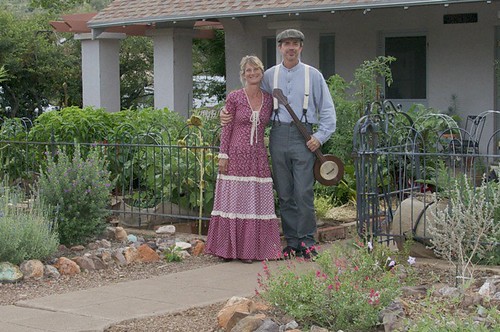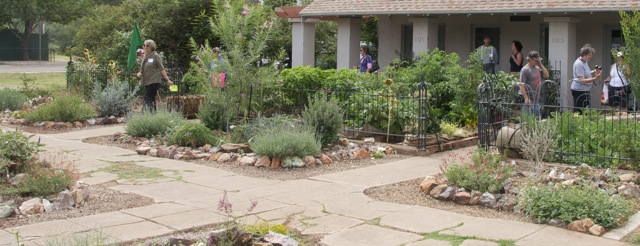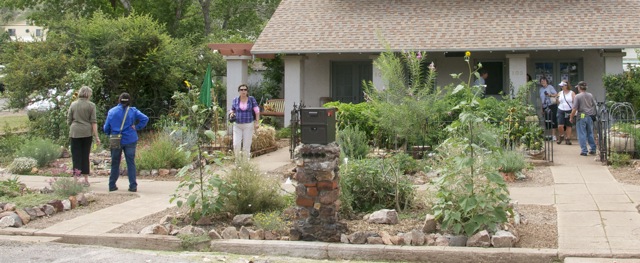In September, we participated in the local Bisbee Bloomer’s garden tour. I admit that I have never attended an event like this before so I really didn’t know what to expect. I worried that my unfinished garden project would pale in comparison to the well-established gardens also included on the tour but I was in for a pleasant surprise.
The beauty of my community’s reputation is that we are an eclectic group. I pacified my insecurity by thinking about the opportunity to share my ideas behind the garden project. The tour was going to bring in a varied group of people, all whom have a common interest in gardens but who also might have different ideas about what an ideal use of a garden might mean. The event gave me another forum besides blogging to share my experiment with growing a kitchen garden and a water-wise flower garden in an area that has challenges with
climate, soil and insects.
After saying that, I confess that I did push the project to complete more than I intended for the first year. In the months leading up to the date, my partner was amazingly supportive to set aside his own projects to assist me on mine. We dug out two more areas of Bermuda grass and set down fresh straw bales since the original set of straw bales had pretty much composted down to the point of being unrecognizable. I started planting the
first of the winter crops for sake of illustration (I still had trouble
convincing some people that the soil that the summer vegetables are growing in
started off like the new straw bales). The task of re-painting the pergola, interrupted
by the monsoon season, was completed. Several more loads of rocks, bricks and
wood chips were gathered from our local resources and incorporated in our
garden space. We also hired our favorite local stonemason to create a new
mailbox. My partner installed a cement border that I jokingly refer to as the
China wall to create a barrier between my neighbors creeping Bermuda lawn and
our rock garden.
Finally, the time came to put all of the garden tools away in the garage for the first time since I started the project last year. We felt ready for the garden tour.

Backing up a bit, the word spread about the straw bale kitchen garden. I was contacted by a reporter for the Arizona Daily Star in Tucson to explain more about it. Since Bisbee is a popular destination for Tucsonans and vice versa, many events are shared between the two communities despite the 90 miles that separate us. To my delight a picture and a quote about my humble straw bale garden experiment was included in the article describing the garden tour event. The curiosity about this relatively novel approach to gardening grew beyond the notice of my immediate neighbors.
 During the event, I fielded many questions about how straw bale gardening
works. We discussed the challenges of the insect pests, especially the
unusually high number of grasshoppers this year. I didn’t know why my garden was spared total decimation. I
did have plenty of grasshoppers happily feeding on my plants. I stressed the
fact that the garden was a product of organic gardening methods and I wouldn’t
think of using a pesticide to control them. I spoke about how the plant
grouping was designed to practice crop rotation next year, the advantages of
polycultures and the philosophy of permaculture. My guests were enthusiastic
listeners and not surprisingly some had more insight than I on these topics.
During the event, I fielded many questions about how straw bale gardening
works. We discussed the challenges of the insect pests, especially the
unusually high number of grasshoppers this year. I didn’t know why my garden was spared total decimation. I
did have plenty of grasshoppers happily feeding on my plants. I stressed the
fact that the garden was a product of organic gardening methods and I wouldn’t
think of using a pesticide to control them. I spoke about how the plant
grouping was designed to practice crop rotation next year, the advantages of
polycultures and the philosophy of permaculture. My guests were enthusiastic
listeners and not surprisingly some had more insight than I on these topics. I will acknowledge that I felt slightly embarrassed when some
of the garden tourists looked to me for expert advise. I admitted that I am
just beginning to learn how to put some of these approaches into practice. But my
guests would have none of that talk and pointed to the health and the size of my
plants. They said that I was doing something right and they wanted in on it.
I will acknowledge that I felt slightly embarrassed when some
of the garden tourists looked to me for expert advise. I admitted that I am
just beginning to learn how to put some of these approaches into practice. But my
guests would have none of that talk and pointed to the health and the size of my
plants. They said that I was doing something right and they wanted in on it. My impression during the garden tour event was that the
interest in straw bale vegetable gardening did not solely stem from the
seasoned gardeners but also from the people who do not identify themselves as such.
I would guess that several of the curious people were intrigue with the idea of
producing healthy food to put on their tables. I hope that my project made it
appear that it was possible for even the inexperienced gardeners to achieve a
level of success in growing their own food at home.
My impression during the garden tour event was that the
interest in straw bale vegetable gardening did not solely stem from the
seasoned gardeners but also from the people who do not identify themselves as such.
I would guess that several of the curious people were intrigue with the idea of
producing healthy food to put on their tables. I hope that my project made it
appear that it was possible for even the inexperienced gardeners to achieve a
level of success in growing their own food at home.
I would like to think that the level of excitement over the
kitchen garden is reflected from the broadening public awareness of our food
system and how it is not working in our best interest. Is this a sign that
there are an ever growing number of people who no longer trust our government to
insure food safety? I live in a relatively conservative area. Is the shift
toward producing food at home becoming a less radical hippy thing to pursue in
suburbia? The subject of food
security in the wake of climate change was brought up more than once in our
conversations. Remember, this event took place in September, before the
hurricane Sandy wake up call. I feel a food revolution coming on.
On that note, I kept a close watch on California’s
proposition 37 to label GMO food during this recent election and I was very
disappointed that it failed to pass. I understand that the corporate money
flooded into the media to discredit the merits of the proposition but all the
same I was hopeful that enough people would see past the food industry’s deliberate
obstructive tactics. Oh well, the fight to hold the food industry accountable
continues on. Just Label It is now refocusing on securing a Federal mandate and addressing the language in
the current draft of the Farm Bill that would strip the authority of federal
agencies to regulate GE crops. I’m not discrediting these important actions but in my mind it seems like a disproportionate struggle for such a small step forward within the big picture.

Although most of the visitors during
the garden tour were excited about the straw bale kitchen garden, I want to
point out that the native and water-wise plants outside the fence also played
an important role in the success of my experiment. They attracted the
pollinators after the sunflowers (leading attractors) faded. One fun instance
that I want to share was when a visitor was surprised to recognize a wild plant,
the red spiderling (Boerhavia coccinea), included in a formal rock garden
setting. She said that it was a weed that grows in the arroyos near her home. Beyond
attracting the pollinators, many of the wild plants are edible, medicinal or
both; for example, the “so called” weed plantain (Plantago lanceolata)
sprouting in my garden.

It is a rare occasion that I expose myself to public
comment. It did occur to me that placing the kitchen garden in the front yard
would attract some attention. The outpouring of positive responses during the
progress of my garden project was amazing and provided sustenance for my soul. The
crowning moment, as a follow-up for the garden tour event, a picture of my
garden was placed directly under the title of the community section in our
local newspaper. To be embraced in this way renewed my hope that the trend
toward sustainable food systems is spreading beyond the interest of the usual
suspects.
Links for further reading:
Forbes: With California Prop Defeated, GMO Labeling Proponents Look to Farm Bill
Praireland Herbs: Plantain
The Bisbee Chamber of Commerce: The Bisbee Bloomers
Arizona Daily Star: 3 tours may spark ideas for your yard
Sierra Vista Herald: Bisbee Bloomers Garden Tour
Found your blog through your DK post. Great to see a fabulous garden thriving in what has to be a very challenging environment. (My problem here in Ithaca, N.Y., is usually too much water and not enough heat units.) Stop by for a visit sometime: http://ellishollow.remarc.com/
ReplyDeleteBut what really caught my eye was your partner's banjo. I think I have one in the attic here that I picked up at a music shop in the Philly area circa 1987. I pull it out every couple of years and figure out a few fiddle tune riffs. But I just haven't made the time to figure out how to make it sing. What do you play on it? Any recommendations on how to get the most out of this splendid piece of work with its coffee can resonator?
May I suggest checking out http://www.banjohangout.org.
DeleteMy partner made the pictured banjo and his passion is collecting old-time music. His handle is Bisbonian at DK and at the Banjo Hangout website. You are welcome to send him a message at either site.
I have to confess that your website has sparked an interest in scanning vegetation. Thank you for sharing.